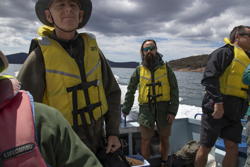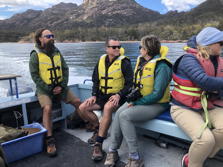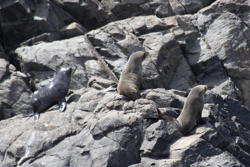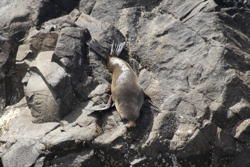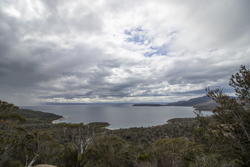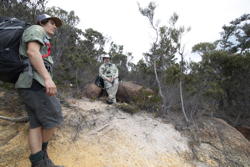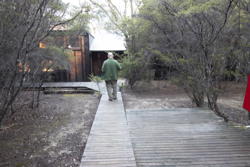
|
|
Those look like pine needles, right? And pine cones, right? Well,
it ain’t no pine tree, it’s Allocasuarina littoralis, very far from being a conifer at all. More information to the side. (You can also get a bigger image, or an even bigger.) |
November 9, we begin our Freycinet Experience
The first third of our sight-seeing and walking adventure would be on the Freycinet Peninsula, midway down the east coast of Tasmania. Most of the peninsula is given over to the Freycinet National Park, our destination. It’s a favorite for Australians, well-known for its beauty and relative isolation. Our walk was managed by Freycinet Experience, a company with a beautiful lodge embedded in the bush, completely hidden from the beach.

White-bellied
sea eagle (Haliaeetus
leucogaster)
(bigger image).
We would be picked up this morning outside our hotel by the Freycinet Experience van, right after breakfast. All of the members of the group met only now, in the lobby. It would be Heidi and Glen, from Sydney; Edwin and Theresa from Vancouver; Marianne, a German who was living and working in Brussels; and us. Our guides would be Isaac, James, and Nick. Our luggage was taken directly to the lodge, but we would go, with our packs, directly to the beach, where we would be picked up by a boat taking us to Schouten Island, directly off the southern end of the peninsula, where we would be hiking up, up, up and then back down, down, down.
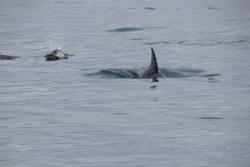
But first we had to get to Schouten Island. From the standpoint of photographic opportunity, this was perhaps the best part of the day. We saw lots of wildlife, much of which Mark got photos of while I did not—too slow on the draw, in many cases. Certainly the picture that he has on his page of the white-bellied sea eagle is much better than mine. (You notice that they’re in the same genus as our bald eagle {Haliaeetus leucocephalus} — our other eagle, the golden eagle, is not closely related at all.) And he was alert enough to get videos of the dolphin pod that approached our boat, while all I have is the one picture you see to the left, not as impressive as Mark’s. (Though my picture does show one spouting.) These are the Short-beaked common dolphin (Delphinus delphis).
As we sailed along the coast, we saw a nest of the sea eagle, and once again, I wasn’t quick enough to aim my camera in the right direction; Mark’s picture is excellent, though, and I recommend it.

The rocky coast of (I believe) the mainland
(big image, small).
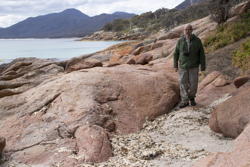
On the rocky beach of Schouten Island,
before
we began to climb (big image, small).
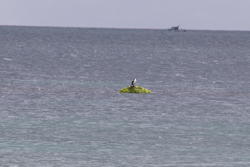
While on the beach we spotted a skerry, way out, and on it a bird that was too far to identify. With my trusty 300-mm lens, though, I could see that it was a cormorant. Indeed, the web seems to tell me that it was a Black-Faced Cormorant (big image, small).
The other sight was a bunch of Australian fur seals basking on rocks as we passed by. As you can read on the Wikipedia page that I linked to, they’re eared seals (Otariidae), and if you look close, you can see the little ear-flaps. Seals proper (Phocidae) have just a little hole on each side of the head. The otariids have two distinct rear flippers, which can be brought forward enough so that they can maneuver relatively well on land, while in the phocids, the two rear limbs are joined in a single flipper, which is their principal propulsion under water, but no help at all on land. The otariids use only the forward flippers for getting through the water, though, and are less efficient swimmers: something of a trade-off.
Noah, the boat’s pilot, delivered us to our trail-head on the beach, where we had a lunch that the guides had brought, and then set off on our walk up the Bear Hill track (needless to say, there are no bears in Australia).
It was on this walk that I slowly came to realize that I had packed my back-pack completely wrong for the day, for the path got very steep and narrow, testing my balance and my leg-strength. The bag was too heavy by far, with a number of inessentials brought along just because I hadn’t put them in my regular roll-aboard suitcase. James took pity on the geezer, though, and offered to take my pack part-way through; this made things considerably easier for me. But on the way down from the (as I recall) 200-meter elevation, we realized that the snazzy walking sticks that we had bought for me specially for this trip did not extend far enough for down-hill hiking. So Mark let me use his, while he made do with the less-useful short sticks.
Very few pictures from this climb: it was, in fact, not so scenic. Just the two that I took when we relaxed at the summit of the track, to the right.
Our guide Isaac was not on the hike, but instead stayed on the water with Noah to go fishing for supper. All the walkers had gotten the offer to stay behind and fish, but all of us did the climb. So we had Isaac to thank when dinner came.
The ride back to the mainland of the Freycinet Peninsula was shorter than the trip out to Schouten Island: Noah piled on the HPs and we were soon back on the mainland. The bus took us a mile or so down the beach from where we were soon walking up into the bush to the lodge, which is well hidden from the beach. Mark and I were shown to our room in a cabin that was a hundred yards or so from the main lodge. It would be just us and Marianne staying there and sharing the shower and toilets. As soon as we got back to the lodge, we were tempted with canapés, which as I recall were not minimal. Mark and I delayed not a moment in pouring some wine for ourselves.
And then came dinner, oh my! This turned out to be one of the best meals we had in Tasmania, and we did enjoy some winners. Isaac did not specify which flatfish he and Noah had caught, but our cooks Daniel and Holly battered and breaded it lightly, fried it to perfection, and left it for us to exclaim over. It was nicely complemented by potatoes and a simple salad. Dessert was a simple panna cotta with fruit, mostly strawberries. Wine of course, from Tasmania of course.
After dinner, we moved down to the sitting room, where Nick explained with a map of the peninsula where we’d be going the next day. Mark and I soon crawled off to our cabin, bright electric torch in hand, to a welcome and cozy bed, perhaps to dream about tomorrow’s adventure. You can read about that on the next page.
